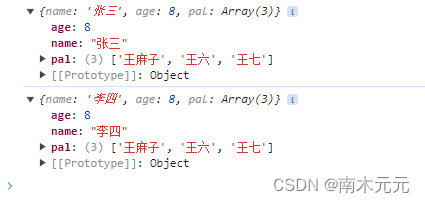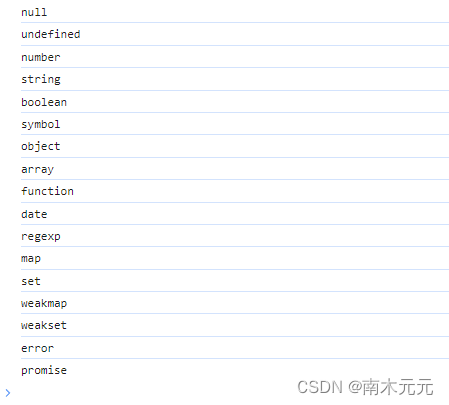前言
📫 大家好,我是南木元元,热爱技术和分享,欢迎大家交流,一起学习进步!
🍅 个人主页:南木元元****
今天来分享一下10个常见的JavaScript手写功能。
1.实现new
(1)首先创建一个新的空对象。
(2)设置原型,将对象的原型设置为函数的prototype对象。
(3)让函数的this指向这个对象,执行构造函数的代码。
(4)判断函数的返回值类型,如果是值类型,返回创建的对象。如果是引用类型,就返回这个引用类型的对象。
function myNew(constructor, ...args) {
// 如果不是一个函数,就报错
if (typeof constructor !== "function") {
throw "myNew function the first param must be a function";
}
// 基于原型链 创建一个新对象,继承构造函数constructor的原型对象上的属性
let newObj = Object.create(constructor.prototype);
// 将newObj作为this,执行 constructor ,传入参数
let res = constructor.apply(newObj, args);
// 判断函数的执行结果是否是对象,typeof null 也是'object'所以要排除null
let isObject = typeof res === "newObject" && res !== null;
// 判断函数的执行结果是否是函数
let isFunction = typeof res === "function";
// 如果函数的执行结果是一个对象或函数, 则返回执行的结果, 否则, 返回新创建的对象
return isObject || isFunction ? res : newObj;
}
// 用法
function Person(name, age) {
this.name = name;
this.age = age;
// 如果构造函数内部,return 一个引用类型的对象,则整个构造函数失效,而是返回这个引用类型的对象
}
Person.prototype.say = function() {
console.log(this.age);
};
let p1 = myNew(Person, "poety", 18);
console.log(p1.name); //poety
console.log(p1); //Person {name: 'poety', age: 18}
p1.say(); //18
测试结果:

2.call、apply、bind
实现call
思路:接受传入的context上下文,如果不传默认为window,将被调用的方法设置为上下文的属性,使用上下文对象来调用这个方法,删除新增属性,返回结果。
//写在函数的原型上
Function.prototype.myCall = function (context) {
// 如果要调用的方法不是一个函数,则报错
if (typeof this !== "function") {
throw new Error("Type error");
}
// 判断 context 是否传入,如果没有传就设置为 window
context = context || window;
// 获取参数,[...arguments]把类数组转为数组
let args = [...arguments].slice(1);
let result = null;
// 将被调用的方法设置为context的属性,this即为要调用的方法
context.fn = this;
// 执行要被调用的方法
result = context.fn(...args);
// 删除手动增加的属性方法
delete context.fn;
// 将执行结果返回
return result;
};
//测试
function f(a,b){
console.log(a+b)
console.log(this.name)
}
let obj={
name:1
}
f.myCall(obj,1,2) // 3,1
测试结果:

实现apply
除了传参方式是数组,其它与call没区别。
Function.prototype.myApply = function (context) {
if (typeof this !== "function") {
throw new Error("Type error");
}
let result = null;
context = context || window;
// 与上面代码相比,我们使用 Symbol 来保证属性唯一,也就是保证不会重写用户自己原来定义在 context 中的同名属性
const fnSymbol = Symbol();
context[fnSymbol] = this;
// 执行要被调用的方法,处理参数和 call 有区别,判断是否传了参数数组
if (arguments[1]) {//传了参数数组
result = context[fnSymbol](...arguments[1]);
} else {//没传参数数组
result = context[fnSymbol]();
}
delete context[fnSymbol];
return result;
};
//测试
function f(a,b){
console.log(a,b)
console.log(this.name)
}
let obj={
name:'张三'
}
f.myApply(obj,[1,2]) //1 2,张三
测试结果:

实现bind
bind返回的是一个函数,需要判断函数作为构造函数的情况,当作为构造函数时,this 指向实例,不会被任何方式改变 this,所以要忽略传入的context上下文。
bind可以分开传递参数,所以需要将参数拼接。
如果绑定的是构造函数,还需要继承构造函数原型上的属性和方法,保证不丢失。
Function.prototype.myBind = function (context) {
// 判断调用对象是否为函数
if (typeof this !== "function") {
throw new Error("Type error");
}
// 获取参数
const args = [...arguments].slice(1);
const fn = this; // 保存this的值,代表调用bind的函数
//返回一个函数,此函数可以被作为构造函数调用,也可以作为普通函数调用
const Fn = function () {
// 根据调用方式,传入不同绑定值
// 当作为构造函数时,this 指向实例,不会被任何方式改变 this,要忽略传入的context上下文
return fn.apply(
this instanceof Fn ? this : context,
// bind可以分开传递参数(如f.bind(obj, 1)(2)),所以需要将参数拼接,这里使用apply,参数拼接成一个数组
args.concat(...arguments)//当前的这个 arguments 是指 Fn 的参数,也可以用剩余参数的方式
);
};
//对于构造函数,要保证原函数的原型对象上的属性不能丢失
Fn.prototype = Object.create(fn.prototype);
return Fn;
};
// 1.先测试作为构造函数调用
function Person(name, age) {
console.log(name);
console.log(age);
console.log(this); //构造函数this指向实例对象
}
// 构造函数原型的方法
Person.prototype.say = function () {
console.log("say");
};
var obj = {
name: "cc",
age: 18,
};
var bindFun = Person.myBind(obj, "cxx");
var a = new bindFun(10);
// cxx
// 10
// Person {}
a.say(); // say
// 2.再测试作为普通函数调用
function normalFun(name, age) {
console.log(name);
console.log(age);
console.log(this); // 普通函数this指向绑定bind的第一个参数 也就是例子中的obj
}
var obj = {
name: "aa",
age: 18,
};
var bindNormalFun = normalFun.myBind(obj, "cc");
bindNormalFun(12);
// cc
// 12
// { name: 'aa', age: 18 }
测试结果:

3.防抖和节流
防抖
防抖是指在事件被触发 n 秒后再执行回调,如果在这 n 秒内事件又被触发,则重新计时。可以使用在一些点击请求的事件上,避免因为用户的多次点击向后端发送多次请求。
//fn是需要防抖的函数,delay是等待时间
function debounce(fn, delay = 500) {
let timer = null;
// 这里返回的函数是每次用户实际调用的防抖函数
return function(...args) { //...args是es6的剩余参数语法,将多余的参数放入数组,用来代替arguments对象
// 如果已经设定过定时器了就清空上一次的定时器
if(timer) {
clearTimeout(timer);
}
// 开始一个新的定时器,延迟执行用户传入的方法;注:定时器的返回值是一个数值,作为定时器的编号,可以传入clearTimeout来取消定时器
timer = setTimeout(() => { //这里必须是箭头函数,不然this指向window,要让this就指向fn的调用者
fn.apply(this, args);
}, delay)
}
}
节流
节流就是一定时间内只执行一次事件,即使重复触发,也只有一次生效。可以使用在监听滚动scroll事件上,通过事件节流来降低事件调用的频率。
- 定时器版本
function throttle(fn, delay = 500) {
let timer = null;
return function(...args) {
// 当前有任务了,直接返回
if(timer) {
return;
}
timer = setTimeout(() => {
fn.apply(this, args);
//执行完后,需重置定时器,不然timer一直有值,无法开启下一个定时器
timer = null;
}, delay)
}
}
- 时间戳版本
// 节流
function throttle(fn, delay = 500) {
let prev = Date.now();// 上一次执行该函数的时间
return function(...args) {
let now = Date.now();//返回从UTC到当前时间的毫秒数
// 如果差值大于等于设置的等待时间就执行函数
if (now - prev >= delay) {
fn.apply(this, args);
prev = Date.now();
}
};
}
详细可以去看我的这篇文章——前端性能优化之防抖&节流
4.实现instanceof
instanceof用于检测构造函数的
prototype
属性是否出现在某个实例对象的原型链上。
function myInstanceof(instance, constructor) {
//如果不是对象,或者是null,直接返回false
if (typeof instance !== "object" || instance === null) {
return false;
}
// 获取对象的原型
let proto = Object.getPrototypeOf(instance);
// 获取构造函数的 prototype 对象
let prototype = constructor.prototype;
// 判断构造函数的 prototype对象是否在对象的原型链上
while (true) {
// 到达原型链终点null,说明没找到
if (!proto) {
return false;
}
if (proto === prototype) {
return true;
}
// 如果没有找到,就继续从其原型上找
proto = Object.getPrototypeOf(proto);
}
}
//测试
let Fn = function () { }
let p1 = new Fn()
console.log(myInstanceof(p1, Fn));//true
console.log(myInstanceof([], Fn));//false
console.log(myInstanceof([], Array)) // true
console.log(myInstanceof(function(){}, Function)) // true
测试结果:

5.实现Ajax
(1)创建一个 XMLHttpRequest 对象。
(2)在这个对象上使用 open 方法创建一个 HTTP 请求(参数为请求方法、请求地址、是否异步和用户的认证信息)。
(3)通过send方法来向服务器发起请求(post请求可以入参数作为发送的数据体)。
(4)监听请求成功后的状态变化:根据状态码进行相应的处理。onreadystatechange设置监听函数,当对象的readyState变为4的时候,代表服务器返回的数据接收完成,这个时候可以通过判断请求的状态,如果状态是200则代表成功,404或500代表失败。
function ajax(url) {
//1.创建XMLHttpRequest对象
const xhr = new XMLHttpRequest();
//2.使用open方法创建一个GET请求
xhr.open('GET',url);
//xhr.open('GET',url,true);//true代表异步,已完成事务的通知可供事件监听器使用;如果为false,send() 方法直到收到答复前不会返回
//3.发送请求
xhr.send();
//4.监听请求成功后的状态变化(readyState改变时触发):根据状态码(0~5)进行相应的处理
xhr.onreadystatechange = function () {
//readyState为4代表服务器返回的数据接收完成
if (xhr.readyState == 4) {
//请求的状态为200或304代表成功
if(xhr.status == 200 || xhr.status == 304) {
//this.response代表返回的数据
handle(this.response);
} else {
//this.statusText代表返回的文本信息
console.error(this.statusText);
}
}
};
}
使用Promise封装AJAX:
function ajax(url) {
return new Promise((resolve, reject) => {
let xhr = new XMLHttpRequest()
xhr.open('get', url)
xhr.send()
xhr.onreadystatechange = () => {
if (xhr.readyState == 4) {
if (xhr.status == 200 || xhr.status == 304) {
resolve(this.response)
} else {
reject(new Error(this.statusText));
}
}
}
})
}
//使用
let url = '/data.json'
ajax(url).then(res => console.log(res))
.catch(reason => console.log(reason))
6.深拷贝和浅拷贝
浅拷贝
浅拷贝是创建一个新对象,这个对象有着原始对象属性值的一份精确拷贝。如果属性是基本类型,拷贝的就是基本类型的值,如果属性是引用类型,拷贝的就是内存地址 ,所以如果其中一个对象改变了这个地址,就会影响到另一个对象。
//实现浅拷贝
function shallowCopy (obj){
// 只拷贝对象,基本类型或null直接返回
if(typeof obj !== 'object' || obj === null) {
return obj;
}
// 判断是新建一个数组还是对象
let newObj = Array.isArray(obj) ? []: {};
//for…in会遍历对象的整个原型链,如果只考虑对象本身的属性,需要搭配hasOwnProperty
for(let key in obj ){
//hasOwnProperty判断是否是对象自身属性,会忽略从原型链上继承的属性
if(obj.hasOwnProperty(key)){
newObj[key] = obj[key];//只拷贝对象本身的属性
}
}
return newObj;
}
//测试
var obj ={
name:'张三',
age:8,
pal:['王五','王六','王七']
}
let obj2 = shallowCopy(obj);
obj2.name = '李四'
obj2.pal[0] = '王麻子'
console.log(obj); //{age: 8, name: "张三", pal: ['王麻子', '王六', '王七']}
console.log(obj2); //{age: 8, name: "李四", pal: ['王麻子', '王六', '王七']}
测试结果:

深拷贝
深拷贝是将一个对象从内存中完整的拷贝一份出来,从堆内存中开辟一个新的区域存放新对象,且修改新对象不会影响原对象。
function deepCopy (obj, map = new WeakMap()){
// 基本类型或null直接返回
if(typeof obj !== 'object' || obj === null) {
return obj;
}
// 判断是新建一个数组还是对象
let newObj = Array.isArray(obj) ? []: {};
//利用map解决循环引用
if (map.has(obj)) {
return map.get(obj);
}
map.set(obj, newObj);//将当前对象作为key,克隆对象作为value
for(let key in obj ){
if(obj.hasOwnProperty(key)){
newObj[key] = deepCopy(obj[key], map); //递归
}
}
return newObj
}
// 测试
let obj1 = {
name : '南木元元',
arr : [1,[2,3],4],
};
let obj2=deepCopy(obj1)
obj2.name = "阿元";
obj2.arr[1] = [5,6,7] ; // 新对象跟原对象不共享内存
console.log('obj1',obj1) // obj1 { name: '南木元元', arr: [ 1, [ 2, 3 ], 4 ] }
console.log('obj2',obj2) // obj2 { name: '阿元', arr: [ 1, [ 5, 6, 7 ], 4 ] }
测试结果:

7.函数柯里化
函数柯里化指的是一种将使用多个参数的一个函数转换成一系列使用一个参数的函数的技术。
作用:可以参数复用(公共的参数已经通过柯里化预置了)和延迟执行(柯里化时只是返回一个预置参数的新函数,并没有立刻执行,在满足条件后才会执行)。
参数定长的柯里化
思路:通过函数的length属性获取函数的形参个数,形参的个数就是所需参数的个数。维护一个数组,当数组的长度与函数接收参数的个数一致,再执行该函数。
// 实现函数柯里化
function curry(fn) {
// 返回一个新函数
return function curried(...args) {
if (args.length >= fn.length) {
return fn.apply(this, args); // 如果参数够了,就执行原函数,返回结果
} else {
//返回一个新函数,继续递归去进行柯里化,利用闭包,将当前已经传入的参数保存下来
return function (...args2) {
//递归调用 curried 函数
return curried.apply(this, [...args, ...args2]); //新函数调用时会继续传参,拼接参数
};
}
};
}
// 测试
function sum(a, b, c) {
return a + b + c;
}
var curried = curry(sum);
console.log(curried(1, 2, 3)); //6
console.log(curried(1, 2)(3)); //6
console.log(curried(1)(2, 3)); //6
console.log(curried(1)(2)(3)); //6
测试结果:

参数不定长的柯里化
题目:如何实现一个方法,使计算结果能够满足如下预期。
add(1, 2, 3) // 6
add(1) // 1
add(1)(2) // 3
add(1, 2)(3) // 6
add(1)(2)(3) // 6
add(1)(2)(3)(4) // 10
思路:利用闭包和递归,如果参数为空,则判断递归结束,求和,返回结果。
function addCurry() {
// 利用闭包的特性收集所有参数值
let arr = [...arguments]
//返回函数
return function fn() {
// 如果参数为空,则判断递归结束,即传入一个()执行函数
if(arguments.length === 0) {
return arr.reduce((a, b) => a + b) // 求和
} else {
arr.push(...arguments)
return fn //递归
}
}
}
// 测试
console.log(addCurry(1)()); //1
console.log(addCurry(1)(2)()); //3
console.log(addCurry(1)(2)(3)()); //6
console.log(addCurry(1, 2)(3)()); //6
console.log(addCurry(1, 2, 3)()); //6
上述写法,总是要以空括号()结尾,于是再改进为隐式转换
.toString
写法,原理:当用 Function的值做计算的时候,会调用toString做隐式转换。注意一些旧版本的浏览器隐式转换会默认执行,新版本不行了。可以利用隐式转换或者alert。
function addCurry() {
let arr = [...arguments]
// 利用闭包的特性收集所有参数值
var fn = function() {
arr.push(...arguments);
return fn;//递归
};
// 利用 toString 隐式转换,转换的时候再返回结果
fn.toString = function () {
return arr.reduce(function (a, b) {
return a + b;
});
}
return fn;
}
//测试
console.log(addCurry(1)(2) == 3) //true 利用隐式转换,自动调用toString方法得到柯里化的结果
//alert(addCurry(1)(2)(3))//6 alert参数只能是字符串,如果其他类型的值,会转换成字符串,会调用toString方法
console.log(addCurry(1).toString());//1 手动调用toString
console.log(addCurry(1, 2)(3).toString());//6
console.log(addCurry(1, 2)(3)(4)(5).toString());//15
测试结果:

8.数组扁平化
数组扁平化其实就是将多维数组转为一维数组。
(1)ES6中的flat
const arr = [1,[2,[3,[4,5]]],6]
// arr.flat([depth]) flat的参数代表的是需要展开几层,如果是Infinity的话,就是不管嵌套几层,全部都展开
console.log(arr.flat(Infinity)) //[1,2,3,4,5,6]
(2)递归
let arr = [1, [2, [3, 4]]];
function flatten(arr) {
let result = [];
for (let i = 0; i < arr.length; i++) {
//如果当前元素还是一个数组
if (Array.isArray(arr[i])) {
result = result.concat(flatten(arr[i]));//递归拼接
} else {
result.push(arr[i]);
}
}
return result;
}
console.log(flatten(arr)); // [1, 2, 3, 4]
(3)reduce函数迭代
从上面普通的递归函数中可以看出,其实就是对数组的每一项进行处理,那么其实也可以用reduce来实现数组的拼接,从而简化第一种方法的代码。
let arr = [1, [2, [3, 4]]];
function flatten(arr) {
return arr.reduce((total, cur) => {
return total.concat(Array.isArray(cur) ? flatten(cur) : cur);
}, []); //传递初始值空数组[],就会从数组索引为 0 的元素开始执行
}
console.log(flatten(arr)); // [1, 2, 3, 4]
(4)split和toString
数组的
toString
方法可以把数组直接转换成逗号分隔的字符串。如[1, [2, [3, 4]]] => "1,2,3,4"
let arr = [1, [2, [3, 4]]];
function flatten(arr) {
//先把数组直接转换成逗号分隔的字符串,然后再用 split 方法把字符串重新转换为数组
return arr.toString().split(",").map(Number);
}
console.log(flatten(arr)); // [ 1, 2, 3, 4 ]
9.数组去重
(1)利用Set。new一个Set,参数为需要去重的数组,Set 会自动删除重复的元素,再Array.from将 Set 转为数组返回。
const arr = [1, 2, 3, 5, 1, 5, 9, 1, 2, 8];
console.log([...new Set(arr)]); //[ 1, 2, 3, 5, 9, 8 ]
console.log(Array.from(new Set(arr))); //[ 1, 2, 3, 5, 9, 8 ]
(2)利用数组的filter() + indexOf去重。利用filter方法,返回arr.indexOf(num)等于index的值。原理就是indexOf会返回最先找到的数字的索引。
function unique(arr) {
return arr.filter((item, index, array) => {
return array.indexOf(item) === index;
});
}
const arr = [1, 2, 3, 5, 1, 5, 9, 1, 2, 8];
console.log(unique(arr)); // [1, 2, 3, 5, 9, 8]
(3)利用map。新建一个数组和map,如果当前值在map中没有出现过,就加入数组,最后返回数组。
const unique = (arr) => {
const map = new Map();
const res = [];
for (let item of arr) {
if (!map.has(item)) {
map.set(item, true);
res.push(item);
}
}
return res;
}
const arr = [1, 2, 3, 5, 1, 5, 9, 1, 2, 8];
console.log(unique(arr)); // [1, 2, 3, 5, 9, 8]
10.手写类型判断函数
思路:如果是null,直接返回String(null);基本类型和函数,直接使用typeof
;
其它引用类型,使用Object.prototype.toString.call。
function getType(value) {
// 判断数据是 null 的情况
if (value === null) {
return String(value);
}
// 判断数据是基本数据类型的情况和函数的情况,使用typeof
if (typeof value !== "object") {
return typeof value;
} else {
// 判断数据是引用类型的情况,设当前类型为date
let valueClass = Object.prototype.toString.call(value); //"[object Date]"
type = valueClass.split(" ")[1].split(""); //[ 'D', 'a', 't', 'e', ']' ] 截取类型并转换为数组
type.pop(); //[ 'D', 'a', 't', 'e' ],去掉数组最后的右括号"]"
return type.join("").toLowerCase(); //[ 'D', 'a', 't', 'e' ] => "Date" => "date" 数组转小写字符串
}
}
// 测试
console.info(getType(null)); // null
console.info(getType(undefined)); // undefined
console.info(getType(100)); // number
console.info(getType("abc")); // string
console.info(getType(true)); // boolean
console.info(getType(Symbol())); // symbol
console.info(getType({})); // object
console.info(getType([])); // array
console.info(getType(() => {})); // function
console.info(getType(new Date())); // date
console.info(getType(new RegExp(""))); // regexp
console.info(getType(new Map())); // map
console.info(getType(new Set())); // set
console.info(getType(new WeakMap())); // weakmap
console.info(getType(new WeakSet())); // weakset
console.info(getType(new Error())); // error
console.info(getType(new Promise(() => {}))); // promise
测试结果:

结语
本文总结了前端常见的一些手写功能,你是不是全都掌握了呢,欢迎在评论区交流。
🔥如果此文对你有帮助的话,欢迎💗关注、👍点赞、⭐收藏、✍️评论,支持一下博主~
版权归原作者 南木元元 所有, 如有侵权,请联系我们删除。